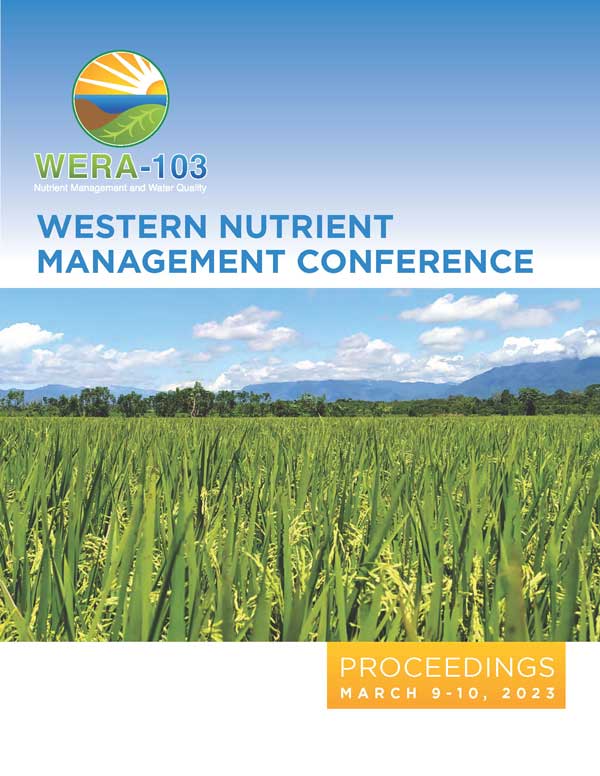Download the Conference Proceedings
Proceedings
Authors
| Filter results8 paper(s) found. |
|---|
1. Water and Nitrogen Interactions in Kentucky BluegrassPressure is increasing in arid regions to conserve water, especially during drought. Turfgrass is the irrigated crop of greatest acreage in the United States and is coming under scrutiny in urban ecosystems. The purpose of this study was evaluating water use by Kentucky bluegrass (Poa pratensis L.) under various irrigation and nitrogen (N) regimes. A study was conducted in an established stand of Kentucky bluegrass in Provo, UT, USA. The turfgrass was split equally into 27 plots (11... A. Hopkins, C. Campbell, B. Hopkins, N. Hansen |
2. Soil Water and Plant Canopy Sensor Technologies to Optimize Water and Nutrient UseIn many respects, agricultural technology is doing things now that were only imagined 20 to 30 years ago. Yet, grower tools that provide information and actionable knowledge on water and nutrient availability still remain a challenge. Clearly, rapid development of data transfer and processing platforms to date has provided rich maps of grower fields with overlays of location-specific information but their utility is still limited by our ability to accurately measure the parameters that are the... C. Campbell, N. Hansen, B. Hopkins, S. Evans, E. Campbell, A. Campbell, L. Rivera, D. Cobos |
3. Nitrogen and Water Interactions: Crop Production Systems Case StudiesFarmers and urban land managers have to strike a tenuous balance between achieving plant growth goals while responsibly managing natural resources. Water quality and scarcity issues are prominent concerns, along with soil quality preservation and conservation of fuel and fertilizer resources. The purpose of this presentation will be to highlight case studies where water and crop management practices were considered together to improve the efficiency of resource use. Evidences of water scarcity... B. Hopkins, N. Hansen |
4. Creating Prescription Variable Rate Irrigation and Fertilization Zones: Water and Nutrient Management InteractionsVariable rate irrigation (VRI) and variable rate fertilization (VRF) technologies allow irrigation and fertilization rates to be spatially customized. VRF is widely adopted, but VRI is an emerging technology with minimal adoption. As water is often the driving force in nutrient cycling, our overall objectives are to evaluate VRI influences on VRF and vice versa; and to combine these technologies to significantly increase crop yield and quality, conserve water, and minimize environmental impacts... J. Svedin, N. Hansen, R. Kerry, R. Christensen, B. Hopkins |
5. Nitrogen and Irrigation Water Interactions in Drought Stressed Kentucky BluegrassThere is increasing pressure in arid regions to conserve water, especially during drought. Turfgrass is the irrigated crop of greatest acreage in the United States and water use for irrigating turf is coming under scrutiny in urban ecosystems. The purpose of this study was to evaluate water use and growth of Kentucky bluegrass (Poa pratensis L.) under various irrigation and nitrogen (N) regimes. A study was conducted in an environmentally controlled growth chamber with established Kentucky... K. Russell, A. Hopkins, N. Hansen, B. Hopkins |
6. Nitrogen Management and Water Productivity of Grain Crops Under Drought or Limited IrrigationThe interactions of nitrogen management and water have been the subject of many studies that have improved crop management practices. Water scarcity however, has become a pressing contemporary challenge for agricultural and food sustainability, especially in many arid and semi-arid regions of the world. As the amount of available water for irrigation decreases, more studies must shift their focus to how nitrogen fertilizers influences water use efficiency. Numerous strategies are currently employed... S. Evans, N. Hansen, A. Blaylock |
7. Drought and Nitrogen Stress Effects on Maize Canopy TemperatureWater scarcity is a major threat to the sustainability of irrigated agriculture. Management practices, such as limited irrigation, that seek to maximize the productivity of a limited water supply are critical. Remote sensing of crop canopy temperature is a useful tool for assessing crop water status and for more precise irrigation management. However, there is potential that nutrient deficiencies could compound the interpretation of water status from leaf temperature by altering leaf color and... A. Carroll, C. Lindsey, J. Baker, B. Hopkins, N. Hansen |
8. Applying a Phosphorus Risk Index in a Mixed-use Mountain WatershedSurface waters in the Wallsburg, UT watershed have been identified as a relatively high contributor of phosphorus (P) to nearby Deer Creek Reservoir. Identifying the major contributors of P is critical for developing effective management practices. Phosphorus Risk Indices have been widely developed as a tool to identify areas with high risk of P movement, but these tools have mostly been applied to watersheds dominated by agricultural land use. While agriculture is often a source of nutrient pollution,... A.W. Pearce, J. Johns, D. Robinson, N. Hansen |
